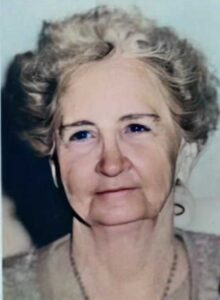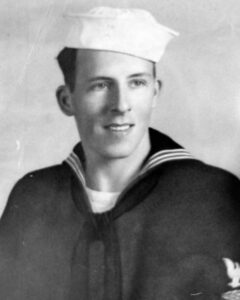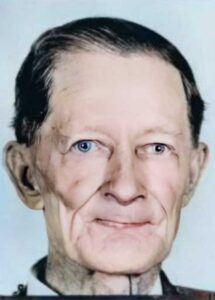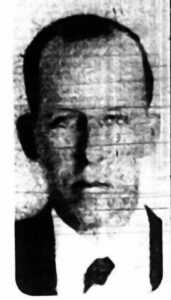Hey all! B.K. Smith here today from Vintage Texas Crimes!
I’ve got a grisly story today that I have never heard about and I grew up just 40 miles south of Houston where it all took place.
Today, on my blog you can read the story, or hear it. This morning, I woke up to a Texas Monthly true crime newsletter in my inbox and I used the “Read it to me” feature that you can subscribe to. I made an executive decision right then. I decided if Texas Monthly can use an AI narrator, so can I.
Now, about the story…
You might need a jacket because this one will send a chill right down your spine. We’re diving into the unsettling mystery of the Rogers family murders, a story that unfolded in Houston, Texas, back in the summer of ‘65.
I came across this story when I was working on another one, of course. I have true crime ADHD and I struggle not to get off track when an old crime I have never heard of presents itself.
This one popped out at me like a wrecking ball today. I was reviewing articles in the Austin Daily Texan (ADT) which is the University of Texas’ student newspaper. I was reading there to refresh my memory on an article. It was about the girls, Susan Jean Rigsby and Shirley Ann Stark, the victims in the book I’m writing on the Austin sorority sister murders which also happened in the summer of 1965.
Anyhow, a four paragraph article in the ADT described the grisly crime I’m going to discuss here, and boy, when I got to the part about what was in the vegetable bin, I couldn’t let it go!. Wanted to share it with you guys! Thanks so much for following me!
Let’s get to it.

The House on Driscoll in Montrose
Part 1: The Icebox Discovery
At 8:55 p.m. on June 23, 1965, as a quarter moon hung in a cloud-flecked sky as two uniformed patrolmen drove up to the Rogers’ home, a one-and-a-half story brick house.

Edwina Harman Rogers
Marvin E. Martin, 56, a nephew of Mrs. Rogers, earlier in the day had called at his aunt’s home. All doors were locked and the front gate was padlocked. He had then gone to the police missing persons’ bureau. He said he feared for his aunt’s safety.
Police officers C. M. Bullock and L. M. Barta were dispatched to meet Martin at the Rogers’ home that night.
Marvin, Edwina Rogers’ nephew, had grown concerned when his repeated phone calls to his aunt went unanswered for days. This wasn’t like Aunt Edwina, so he decided to call the authorities. Two Houston police officers were dispatched to the Rogers’ home on Driscoll Street.
Now, picture this: the officers entered the house. Nothing immediately appeared out of place, even dinner was sitting out on the dining room table. But then, Officer Bullock, decided to check the refrigerator. What he found next… well, it was beyond comprehension.

The Kitchen Sink in the Rogers’ House

The Refrigerator where the Body was Stored

Charles F. Rogers, Navy
Inside, neatly stacked on the shelves, were numerous cuts of what the officer initially mistook for butchered hog meat. But as he went to close the door, his eyes caught something truly horrific through the clear glass of the vegetable bin: two human heads. They were the heads of Fred and Edwina Rogers, the elderly parents who lived in the home. The ‘hog meat’ was, in fact, their dismembered limbs and torsos.
The scene inside the house was disturbing. Authorities later determined that Fred and Edwina Rogers had likely been killed three days prior, on Father’s Day, June 20th. The autopsy revealed a brutal end for both of them. Fred Rogers had been struck multiple times in the head with a claw hammer. The mad man who butchered the Rogers couple had dismembered the body of Mr. Rogers at the joints, at the ankles, knees, hips, shoulders, wrists and elbows. He had done the same on the body of Mrs. Rogers, except he had left her elbows intact..
The head of each was severed at the neckline. The chest sections of each had been cut open and the spines sawed in two. The intestines and vital organs were missing. So were Mr. Roger’s genitalia.
The dimension of the crime was further magnified, if possible, by a final gross act of the butcher. The eyes of the Rogers were crudely gouged out of their sockets.

Frederick C. Rogers
Edwina Rogers had been beaten and then shot, execution-style, in the head.
Adding to the horror, investigators discovered the couple’s organs in a nearby sewer. They had been meticulously removed, cut up, and flushed down the toilet. Other remains of Fred and Edwina were never found. The dismemberment itself seemed to have been carried out by someone “with some knowledge of anatomy,” likely in the upstairs bathroom. What made this even more unsettling was the apparent lack of blood in the house, suggesting a thorough cleanup after the gruesome acts.
So, who could commit such a heinous crime? Suspicion immediately fell upon their own son, Charles Frederick Rogers. Charles, a 43-year-old seismologist and pilot with a degree in nuclear physics, was unemployed and living with his parents. He was described as “reclusive,” even communicating with his parents by slipping notes under his bedroom door. Neighbors were unaware that he even lived there, as he would leave before dawn and return late at night.
Part 2 – Who Were the Rogers?
Let’s talk about who these people were. We will begin with the patriarch and matriarch, Fred Christopher Rogers and Edwina Ivor Rogers (née Harman). Fred was born on January 19, 1884, and Edwina on October 8, 1892.
Two years before Charles was born, the Rogers had a daughter, Bettie Charlotte Rogers, born in 1919. Two years later, on December 30, 1921, Charles Frederick Rogers was born. Charles’ birth certificate stated that Mr. Rogers, age 34, worked in Real Estate and Mrs. Rogers, age 29, was a housewife. Charles’ mother listed herself as “Ebbie (Harman) Rogers” on the birth certificate and by the same name on her marriage certificate from July 24, 1914.
In 1929, the family suffered a tragedy when Bettie was killed in an automobile accident in Gonzales, Texas.

Employee – Shell
By 1965, they were 72 and 77, and living with their son, Charles, in their Montrose neighborhood home in Houston.
Our primary focus, of course, is on their son, Charles Frederick Rogers, the sole suspect in their brutal murders. Charles was born on December 30, 1921. He was highly intelligent, earning a Bachelor of Science degree in nuclear physics from the University of Houston. His expertise extended beyond academics; he spoke seven languages and served as a pilot in the U.S. Navy during World War II, also serving in the Office of Naval Intelligence. After the war, he worked as a seismologist for Shell Oil for nine years, abruptly quitting in 1957 without explanation.
Those who knew Charles described him as highly intelligent, with a talent for finding gas, oil, and gold for companies he worked for. He also had an interest in ham radios. In the mid-1950s, Charles reportedly joined the Civil Air Patrol, where he is said to have met David Ferrie, a name later connected to the assassination of President John F. Kennedy.
By 1965, the year of the murders, Charles was unemployed and living with his parents. This living arrangement was far from conventional. Charles was described as “reclusive,” even within his own home.
Forensic accountant Hugh Gardenier and his wife Martha, who extensively researched the case, believe that Charles’s father, Fred, was abusive and that both parents were “devious con artists.” They theorize that Fred was a bookie involved in illegal activities like gambling and fraud, and that he continued to abuse Charles into adulthood, allegedly stealing large sums of money from him. They lay this all out in a book called “The Icebox Murders.”
Adding another layer to the mystery, some theories, particularly the one presented in “The Man on the Grassy Knoll,” suggest that Charles Rogers was a CIA agent who may have been involved in the assassination of President John F. Kennedy. This theory posits that Charles murdered his parents because his mother was tracking his phone calls and becoming suspicious.
It’s important to remember that these theories surrounding CIA involvement and the JFK assassination are largely based on speculation. However, even the more grounded theories from investigators like the Gardeniers paint a picture of a deeply troubled family dynamic with the potential for significant conflict.
Charles’ last known employment was with Shell Oil Co. in Houston as a member of a seismograph crew. He worked for Shell in Canada for a year, but that had all ended eight years earlier in 1957.
A check by authorities of Social Security records disclosed no payments had been made to his account since then.
Perhaps the best description of Charles Rogers was given by a cousin, George Harman:
“He was like a morning fog. He just faded in and faded out.”
A search of the house revealed very little blood, but what little they found was traced to Charles Rogers’ bedroom.
About the missing man’s personality, hobbies, or life, police say they know very little. And neighbors and relatives say they know less.
He did his own cooking on a 2-burner hot plate in his room. Police found an assortment of musical instruments in his room: A saxophone, an electric organ, a French horn, a mandolin, and a trombone.
They also found a .22 caliber pistol on his nightstand. An autopsy later disclosed that Mrs. Rogers had been shot in the head with a small caliber pistol. Fragments of a slug were found in her brain. Rogers, her husband, had been beaten to death, apparently with a blood-stained hammer found in the home.
Police also found a keyhole saw on which a chemist discovered bits of human flesh. And traces of blood were found on the walls and floor of the downstairs bathroom of the Rogers home. Also at the crime scene, police found a blood-stained straight razor.
Authorities theorize the killer shot Mrs. Rogers, beat her husband to death with the hammer, then dismembered their bodies with the straight razor and key- hole saw.
Two days after the crime was discovered, neighbors complained of an odor emanating from a sewer line in the area. A city works crew and prison farm trusties trolled the sewer line. They recovered what have been identified as parts of the human body: Lungs, kidney, liver, and viscera.
Naturally, a warrant was issued for him as a material witness, but he vanished without a trace.
This wasn’t just a case of a double homicide; it was a bizarre and chilling mystery. The level of violence, the dismemberment, the attempted disposal of the bodies – it all pointed to something deeply disturbing. And the disappearance of Charles Rogers only deepened the enigma.
In a statement given by Marvin Martin, the nephew of Edwina Rogers, he said that Mrs. Rogers told him once she had talked to a doctor about her son Charles. She was advised, said Martin, “To just let him alone and not agitate the boy by trying to get him to go to a doctor.”
A maid, Laverne Johnson, 33, who says she’s worked for Mrs. Rogers for five years, told po- lice she had “never once seen the son” during that time.
The maid quoted Mrs. Rogers as saying that the son once “jumped on his daddy and began choking him.”
Mrs. Rogers intervened, said the maid, and the son told his parents: “I don’t want to have anything to do with you anymore.”
Police had a 9-year-old photograph of the missing son taken during his employment at Shell, but little else.
Interestingly, a day after the torso slayings, a man with a receding hairline, apparently wearing mascara on his eyebrows and a pencil-thin mustache applied for overseas employment at the Fluor Corporation.
He sought work as a welder or “immediate overseas duty in Japan or Australia.”
The media quickly latched onto the gruesome details, dubbing it “The Icebox Murders.” And while Charles Rogers remains the only official suspect, the case has never been officially solved. Ten years later, in 1975, a judge declared him legally dead, but the questions surrounding the murders and his disappearance continue to linger.
Over the years, various theories have emerged, some more outlandish than others. This is a truly disturbing case that continues to baffle investigators and fascinate true crime enthusiasts to this day.
Part 3- Theories
Alright, let’s delve deeper into the theories put forth by those fascinated by this case.
Here’s a breakdown of their key beliefs, drawing from their research:
- Charles Rogers as the Killer: The Gardeniers have concluded that Charles Rogers did indeed kill his parents, Fred and Edwina Rogers. This aligns with the initial police suspicion, given Charles’ disappearance and the evidence found in his room.
- “The Man on the Grassy Knoll” Theory: This book by John R. Craig and Philip A. Rogers claims Charles Rogers was a CIA agent involved in the assassination of President John F. Kennedy. The theory alleges Rogers impersonated Lee Harvey Oswald in Mexico City, was one of two shooters, and was one of the “three tramps” arrested in Dealey Plaza. It also suggests Rogers murdered his parents because his mother was becoming suspicious of his clandestine activities. This theory further proposes Rogers fled to Guatemala after the murders and assassination. However, a Publishers Weekly review notes the book’s excessive “poetic license” and lack of sourcing, indicating a high degree of speculation.
- Hugh and Martha Gardenier’s Perspective: Houston forensic accountant Hugh Gardenier and his wife Martha acknowledge a potential, albeit indirect, link to the CIA. They dismiss the claim that Rogers was a CIA operative but admit he had dealings with CIA contract workers during his time as a seismologist. They suggest Rogers’s profession, involving skills valuable to intelligence gathering, may have led to interactions with individuals connected to the agency. Their theory about the motive for the murders centers on abuse and financial exploitation by his parents, leading to his flight to Mexico and eventual death in Honduras.
- Other Mentions of CIA Connections: Various sources mention Rogers’s alleged CIA involvement. One source states he was involved in the JFK assassination and worked for the CIA. Another source mentions the “perspectives from Rogers’s son, who believes his father… potentially had CIA connections.” It’s important to note that these are beliefs and claims, not confirmed evidence.
- Motive: Abuse and Financial Exploitation: The Gardeniers believe that the motive behind the murders lies in the dysfunctional family dynamics. They contend that Charles’s father, Fred, was abusive, and both parents were “devious con artists” . Specifically, they theorize that Fred Rogers worked as a bookie involved in illegal activities like gambling and fraud. Furthermore, they believe that Fred continued to abuse Charles into adulthood and began stealing large sums of money from him, ultimately pushing Charles to commit the horrific acts.
- Flight and Death in Honduras: Following the murders and dismemberment of his parents, the Gardeniers believe that Charles Rogers fled the United States for Mexico. They theorize that he was able to evade authorities with the aid of “powerful friends” he had cultivated through his ham radio hobby and his work for various oil and mining companies. Their theory goes further, suggesting that Rogers eventually made his way to Honduras, where he was ultimately killed over a wage dispute with miners.
- “Fact-Based Fiction” Novel: The Gardeniers have presented their findings and theories in a novel titled “The Ice Box Murders,” published in October 2003 . It’s described as “fact-based fiction and supposition,” showing that, while rooted in their research, it also incorporates fictional elements and interpretations. Notably, the book includes “many unnamed characters”: various politicians and attorneys as well as the eyewitness who said he saw Rogers in Honduras after 1965. This highlights that some aspects of their theory, particularly regarding Rogers’s fate in Honduras, rely on anecdotal evidence and their interpretations.
In essence, the Gardeniers paint a picture of Charles Rogers as a man driven to murder by a lifetime of abuse and financial exploitation at the hands of his parents. They believe he leveraged his connections to escape the country and ultimately met a violent end in Honduras. While they acknowledge his potential tangential links to the CIA through his work, they reject the more elaborate conspiracy theories surrounding his involvement in the JFK assassination. It’s important to remember that their book is described as “fact-based fiction,” meaning it contains fictional elements alongside their research. Additionally, some of their conclusions rely on anecdotal evidence. Their work has undoubtedly contributed to the ongoing fascination and investigation surrounding the Rogers’ family murders.
UPDATE 4/8/2025 – I wondered why the Rogers didn’t kick their son out of the house since he was so surly to them. Here’s why: It was HIS house. They lived there rent free.
Three years earlier: Charles Rogers owned two lots where Astroworld was going to be built and his father sold both of them without the son knowing it.
Edwina and Fred also put a lien against the house for $10,000 which was half of the home’s value and is more than was the median income for a year in 1965.
They paid off Fred’s gambling debts and apparently found more ways to fritter away the equity in his home. Charles found out about the shenanigans.
While neither of those things (blatant theft from your son) is a good reason to murder your parents, if Charles was the killer, it certainly puts a different light on the family.

Mary Leigh
So very interesting. And very creepy. Excellent morning read.
BK Smith
Thanks, Mary! I really appreciate that!
Mary Leigh
So very interesting. And very creepy. Excellent morning read.
Rita Nelson
Interesting read. Being from the Houston area I had never heard of these murders.
BK Smith
Wow, thanks, Rita. I appreciate you commenting! I grew up in Angleton and Freeport. I can’t believe I never heard of it.
BK Smith
Thanks! I appreciate it.